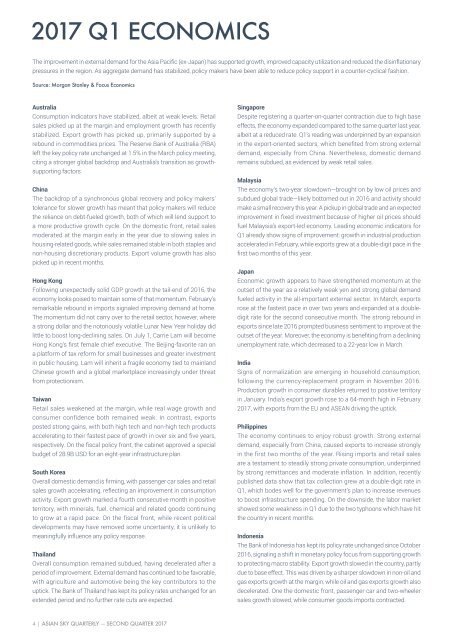ASQ7 EN (20170705)
Create successful ePaper yourself
Turn your PDF publications into a flip-book with our unique Google optimized e-Paper software.
2017 Q1 ECONOMICS<br />
The improvement in external demand for the Asia Pacific (ex-Japan) has supported growth, improved capacity utilization and reduced the disinflationary<br />
pressures in the region. As aggregate demand has stabilized, policy makers have been able to reduce policy support in a counter-cyclical fashion.<br />
Source: Morgan Stanley & Focus Economics<br />
Australia<br />
Consumption indicators have stabilized, albeit at weak levels. Retail<br />
sales picked up at the margin and employment growth has recently<br />
stabilized. Export growth has picked up, primarily supported by a<br />
rebound in commodities prices. The Reserve Bank of Australia (RBA)<br />
left the key policy rate unchanged at 1.5% in the March policy meeting,<br />
citing a stronger global backdrop and Australia’s transition as growthsupporting<br />
factors.<br />
China<br />
The backdrop of a synchronous global recovery and policy makers’<br />
tolerance for slower growth has meant that policy makers will reduce<br />
the reliance on debt-fueled growth, both of which will lend support to<br />
a more productive growth cycle. On the domestic front, retail sales<br />
moderated at the margin early in the year due to slowing sales in<br />
housing-related goods, while sales remained stable in both staples and<br />
non-housing discretionary products. Export volume growth has also<br />
picked up in recent months.<br />
Hong Kong<br />
Following unexpectedly solid GDP growth at the tail-end of 2016, the<br />
economy looks poised to maintain some of that momentum. February’s<br />
remarkable rebound in imports signaled improving demand at home.<br />
The momentum did not carry over to the retail sector, however, where<br />
a strong dollar and the notoriously volatile Lunar New Year holiday did<br />
little to boost long-declining sales. On July 1, Carrie Lam will become<br />
Hong Kong’s first female chief executive. The Beijing-favorite ran on<br />
a platform of tax reform for small businesses and greater investment<br />
in public housing. Lam will inherit a fragile economy tied to mainland<br />
Chinese growth and a global marketplace increasingly under threat<br />
from protectionism.<br />
Taiwan<br />
Retail sales weakened at the margin, while real wage growth and<br />
consumer confidence both remained weak. In contrast, exports<br />
posted strong gains, with both high tech and non-high tech products<br />
accelerating to their fastest pace of growth in over six and five years,<br />
respectively. On the fiscal policy front, the cabinet approved a special<br />
budget of 28.9B USD for an eight-year infrastructure plan.<br />
South Korea<br />
Overall domestic demand is firming, with passenger car sales and retail<br />
sales growth accelerating, reflecting an improvement in consumption<br />
activity. Export growth marked a fourth consecutive month in positive<br />
territory, with minerals, fuel, chemical and related goods continuing<br />
to grow at a rapid pace. On the fiscal front, while recent political<br />
developments may have removed some uncertainty, it is unlikely to<br />
meaningfully influence any policy response.<br />
Thailand<br />
Overall consumption remained subdued, having decelerated after a<br />
period of improvement. External demand has continued to be favorable,<br />
with agriculture and automotive being the key contributors to the<br />
uptick. The Bank of Thailand has kept its policy rates unchanged for an<br />
extended period and no further rate cuts are expected.<br />
Singapore<br />
Despite registering a quarter-on-quarter contraction due to high base<br />
effects, the economy expanded compared to the same quarter last year,<br />
albeit at a reduced rate. Q1’s reading was underpinned by an expansion<br />
in the export-oriented sectors, which benefited from strong external<br />
demand, especially from China. Nevertheless, domestic demand<br />
remains subdued, as evidenced by weak retail sales.<br />
Malaysia<br />
The economy’s two-year slowdown—brought on by low oil prices and<br />
subdued global trade—likely bottomed out in 2016 and activity should<br />
make a small recovery this year. A pickup in global trade and an expected<br />
improvement in fixed investment because of higher oil prices should<br />
fuel Malaysia’s export-led economy. Leading economic indicators for<br />
Q1 already show signs of improvement: growth in industrial production<br />
accelerated in February, while exports grew at a double-digit pace in the<br />
first two months of this year.<br />
Japan<br />
Economic growth appears to have strengthened momentum at the<br />
outset of the year as a relatively weak yen and strong global demand<br />
fueled activity in the all-important external sector. In March, exports<br />
rose at the fastest pace in over two years and expanded at a doubledigit<br />
rate for the second consecutive month. The strong rebound in<br />
exports since late 2016 prompted business sentiment to improve at the<br />
outset of the year. Moreover, the economy is benefiting from a declining<br />
unemployment rate, which decreased to a 22-year low in March.<br />
India<br />
Signs of normalization are emerging in household consumption,<br />
following the currency-replacement program in November 2016.<br />
Production growth in consumer durables returned to positive territory<br />
in January. India’s export growth rose to a 64-month high in February<br />
2017, with exports from the EU and ASEAN driving the uptick.<br />
Philippines<br />
The economy continues to enjoy robust growth. Strong external<br />
demand, especially from China, caused exports to increase strongly<br />
in the first two months of the year. Rising imports and retail sales<br />
are a testament to steadily strong private consumption, underpinned<br />
by strong remittances and moderate inflation. In addition, recently<br />
published data show that tax collection grew at a double-digit rate in<br />
Q1, which bodes well for the government’s plan to increase revenues<br />
to boost infrastructure spending. On the downside, the labor market<br />
showed some weakness in Q1 due to the two typhoons which have hit<br />
the country in recent months.<br />
Indonesia<br />
The Bank of Indonesia has kept its policy rate unchanged since October<br />
2016, signaling a shift in monetary policy focus from supporting growth<br />
to protecting macro stability. Export growth slowed in the country, partly<br />
due to base effect. This was driven by a sharper slowdown in non-oil and<br />
gas exports growth at the margin, while oil and gas exports growth also<br />
decelerated. One the domestic front, passenger car and two-wheeler<br />
sales growth slowed, while consumer goods imports contracted.<br />
4 | ASIAN SKY QUARTERLY — SECOND QUARTER 2017

















